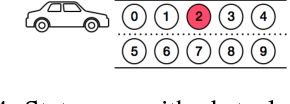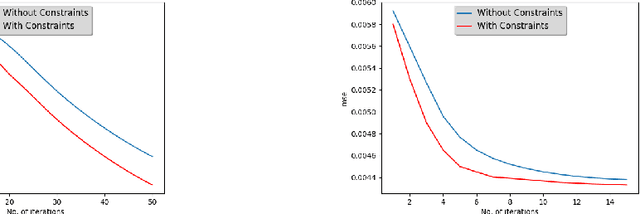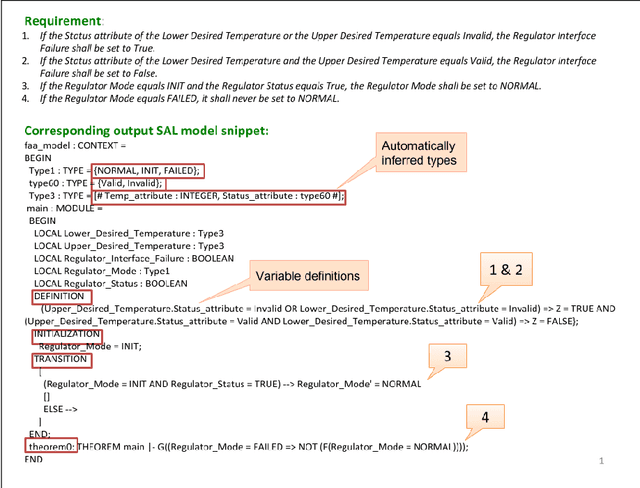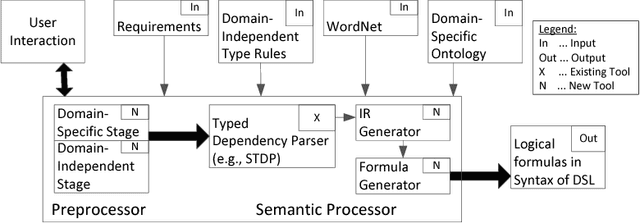Patrick Lincoln
Neuro Symbolic Reasoning for Planning: Counterexample Guided Inductive Synthesis using Large Language Models and Satisfiability Solving
Sep 28, 2023



Abstract:Generative large language models (LLMs) with instruct training such as GPT-4 can follow human-provided instruction prompts and generate human-like responses to these prompts. Apart from natural language responses, they have also been found to be effective at generating formal artifacts such as code, plans, and logical specifications from natural language prompts. Despite their remarkably improved accuracy, these models are still known to produce factually incorrect or contextually inappropriate results despite their syntactic coherence - a phenomenon often referred to as hallucination. This limitation makes it difficult to use these models to synthesize formal artifacts that are used in safety-critical applications. Unlike tasks such as text summarization and question-answering, bugs in code, plan, and other formal artifacts produced by LLMs can be catastrophic. We posit that we can use the satisfiability modulo theory (SMT) solvers as deductive reasoning engines to analyze the generated solutions from the LLMs, produce counterexamples when the solutions are incorrect, and provide that feedback to the LLMs exploiting the dialog capability of instruct-trained LLMs. This interaction between inductive LLMs and deductive SMT solvers can iteratively steer the LLM to generate the correct response. In our experiments, we use planning over the domain of blocks as our synthesis task for evaluating our approach. We use GPT-4, GPT3.5 Turbo, Davinci, Curie, Babbage, and Ada as the LLMs and Z3 as the SMT solver. Our method allows the user to communicate the planning problem in natural language; even the formulation of queries to SMT solvers is automatically generated from natural language. Thus, the proposed technique can enable non-expert users to describe their problems in natural language, and the combination of LLMs and SMT solvers can produce provably correct solutions.
Trusted Neural Networks for Safety-Constrained Autonomous Control
May 18, 2018



Abstract:We propose Trusted Neural Network (TNN) models, which are deep neural network models that satisfy safety constraints critical to the application domain. We investigate different mechanisms for incorporating rule-based knowledge in the form of first-order logic constraints into a TNN model, where rules that encode safety are accompanied by weights indicating their relative importance. This framework allows the TNN model to learn from knowledge available in form of data as well as logical rules. We propose multiple approaches for solving this problem: (a) a multi-headed model structure that allows trade-off between satisfying logical constraints and fitting training data in a unified training framework, and (b) creating a constrained optimization problem and solving it in dual formulation by posing a new constrained loss function and using a proximal gradient descent algorithm. We demonstrate the efficacy of our TNN framework through experiments using the open-source TORCS~\cite{BernhardCAA15} 3D simulator for self-driving cars. Experiments using our first approach of a multi-headed TNN model, on a dataset generated by a customized version of TORCS, show that (1) adding safety constraints to a neural network model results in increased performance and safety, and (2) the improvement increases with increasing importance of the safety constraints. Experiments were also performed using the second approach of proximal algorithm for constrained optimization --- they demonstrate how the proposed method ensures that (1) the overall TNN model satisfies the constraints even when the training data violates some of the constraints, and (2) the proximal gradient descent algorithm on the constrained objective converges faster than the unconstrained version.
ARSENAL: Automatic Requirements Specification Extraction from Natural Language
Apr 20, 2016



Abstract:Requirements are informal and semi-formal descriptions of the expected behavior of a complex system from the viewpoints of its stakeholders (customers, users, operators, designers, and engineers). However, for the purpose of design, testing, and verification for critical systems, we can transform requirements into formal models that can be analyzed automatically. ARSENAL is a framework and methodology for systematically transforming natural language (NL) requirements into analyzable formal models and logic specifications. These models can be analyzed for consistency and implementability. The ARSENAL methodology is specialized to individual domains, but the approach is general enough to be adapted to new domains.
Virus Detection in Multiplexed Nanowire Arrays using Hidden Semi-Markov models
Jul 16, 2014



Abstract:In this paper, we address the problem of real-time detection of viruses docking to nanowires, especially when multiple viruses dock to the same nano-wire. The task becomes more complicated when there is an array of nanowires coated with different antibodies, where different viruses can dock to each coated nanowire at different binding strengths. We model the array response to a viral agent as a pattern of conductance change over nanowires with known modifier --- this representation permits analysis of the output of such an array via belief network (Bayes) methods, as well as novel generative models like the Hidden Semi-Markov Model (HSMM).
 Add to Chrome
Add to Chrome Add to Firefox
Add to Firefox Add to Edge
Add to Edge